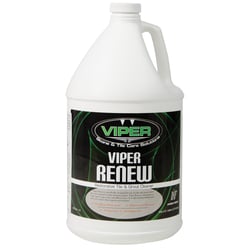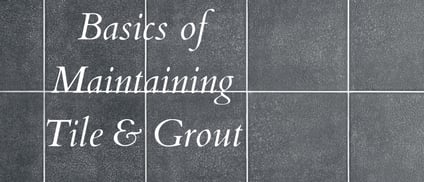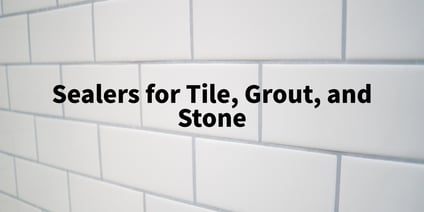Efflorescence – Efflorescence is a white crystalline or powdery deposit on grout lines, stone, or porous tile. It’s caused by water traveling through the floor. The water dissolves salts and minerals in concrete or grout and then evaporates leaving the minerals deposited on the surface.

- Light deposits can be removed with a stiff brush or agitation by a white or beige pad under a rotary floor machine. Efflorescence may wear off over time with foot traffic.
- Heavier deposits, especially with a crystalline appearance, are more difficult and are best dissolved using a restorative acid cleaner. Be sure to protect surfaces not being treated. Use proper personal protective equipment.
- Wipe this onto the affected surface using a sponge, brush, or strip washer.
- Rinse and extract. Use a minimum amount of moisture, as excess moisture can start the formation of efflorescence again. In small areas, this may be as simple as wiping with a damp towel. Whatever method you use, the goal is to dissolve the efflorescence with the acid solution but not allow any water to flow back down into the grout.
Sealer Haze or Excess Sealer – Sealers for grout and stone should be impregnating or topical sealers that are absorbed down into the grout to fill the pores, crevices, and capillaries. Topical finishes that stay on the surface are not intended for use on ceramic and porcelain tile.
Grout and stone will not hold an unlimited amount of sealer. When more sealer is applied than the substrate can contain, the excess sealer will dry on the surface. This can appear as a smooth milky white haze. In some cases, this leaves the floor tacky or sticky.
Sealer haze on the surface of stone or tile will eventually wear off with traffic. It may be buffed off with a white or beige buffing pad. Sometimes sealer is applied to a ceramic tile floor and a moss rubber or foam squeegee is used to move the sealer to the grout lines where it is needed. Buffing within 10 minutes or so after the sealer has been applied is a good way to quickly remove this excess sealer.
Sealers in depressed grout lines can be removed by wiping with a towel saturated with fresh sealer. This will dissolve or re-emulsify the excess which can then be wiped away.
In extreme conditions, excess sealer can be stripped off the floor using an alkaline stone cleaner or a product for stripping VCT floors with a rotary floor machine and an appropriate scrubbing pad or brush.
Oil Stains – Oil can penetrate deeply into porous grout and stone. The protection provided by applying and maintaining a good sealer is the best prevention.
When oil or grease stains occur that are not removed by normal cleaning, they can be removed with a poultice.
- Apply standard industry poultice over the stained area and extend up to 1” beyond the stain. ¼” thick yes and only ¼” beyond the stain. Take a piece of plastic wrap and place it over the poultice. Using temporary tape like Dragon Skin Premium Blue Painter’s Tape, adhere the edge of the plastic wrap to the surrounding surface to create an airtight seal.
- Allow 24 hours for the poultice to emulsify the oils and draw them into the poultice.
- Remove plastic and the tape taking care not to remove the poultice with it
- Leave uncovered allowing the poultice to dry naturally
- Remove dried material by sweeping or vacuuming.
- Wait an additional 24 hours for the surface to dry completely.
- A second application may be required for heavy deposits.
Rust Stains – Light rust stains may be removed with acidic restorative cleaning procedures. Deeper rust stains will respond to stronger acidic dilutions. CAUTION: Acid cleaning is not appropriate for many types of stone. For rust stains on limestone, marble, or travertine, polishing with diamond polishing pads may be required.
Sometimes the source of the rust is iron or metal in contact with the surface of the stone. Other times the source of the rust may be trace amounts of iron in the stone. If the rust comes from within the stone, it is likely to recur after cleaning. Be sure to educate your clients about this possibility.
Food Stains – for coffee, tea, wine, mustard, catsup, and many other food and beverage stains.
- Wet the area with an oxidizing stain remover.
- Apply standard industry poultice according to label directions.
- Apply at least ¼” thick over the stained area and extend up to 1” beyond the stain.
- Allow 24 hours for the poultice to dry completely and remove the stain.
- Remove dried material by sweeping or vacuuming.
Topical Coatings –Floors may have a build-up of topical coatings or finishes. Abrasive particles like sand along with foot traffic grinding these particles against a hard surface quickly grind off surface finishes. This makes for a blotchy appearance and requires regular maintenance to keep it looking good. Stone, porous tile, and grout should be treated with penetrating finishes rather than topical coatings. Here is a process to remove topical coatings.
- Sweep or vacuum the floor to remove particle soils. An untreated microfiber dust mop is suggested.
- Protect surfaces not being cleaned so that they are not damaged by splashes or spills.
- If you know what topical sealer was applied, there is often a companion product to remove the finish. Use that product according to the label directions. You can use other alkaline products meant to strip VCT. Apply liberally. Allow 10 minutes of dwell time.
- Grout lines will need to be agitated with a grout brush.
- Use a rotary floor machine with an appropriate brush or stripping pad to loosen and emulsify the finish.
- Remove the slurry and then rinse the floor so no residue remains. This may be done with a squeegee and mop or by machine.
- Heavy coatings may require multiple cleanings.
by Scott Warrington
Enjoyed reading this post? Read the following articles:
Featured Products

Hydro-Force, Hard Surface Cleaner, Viper Renew Restorative Tile & Grout Cleaner, 1 Gallon

Bridgepoint Systems, Stain Remover, Stain Zone, Oxidizer, 1 Quart



